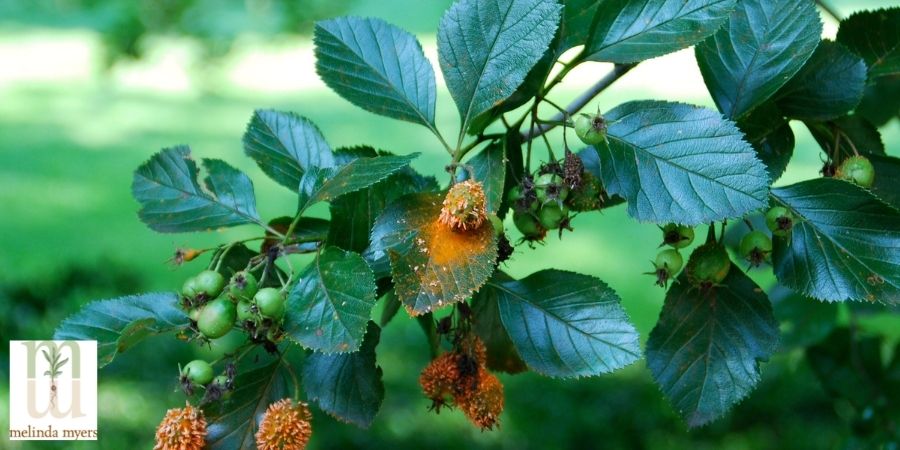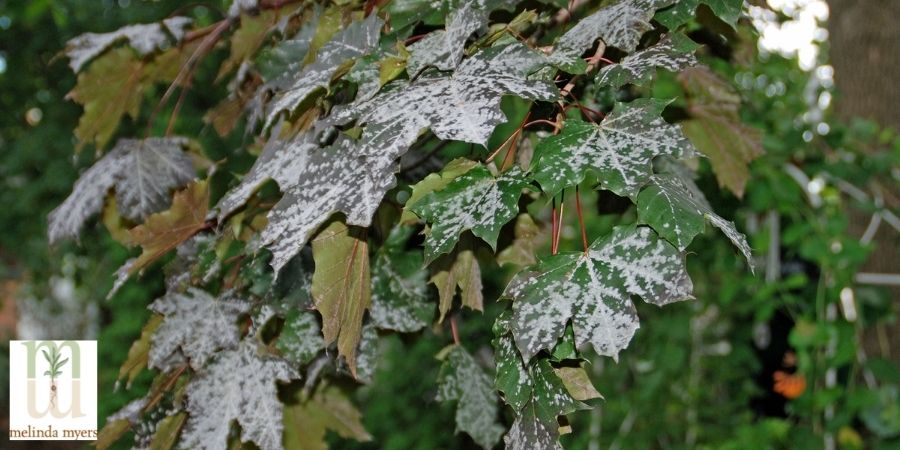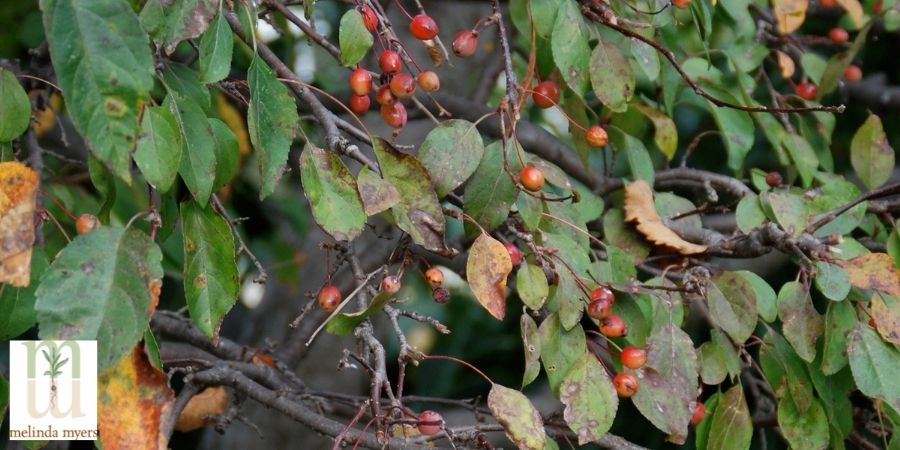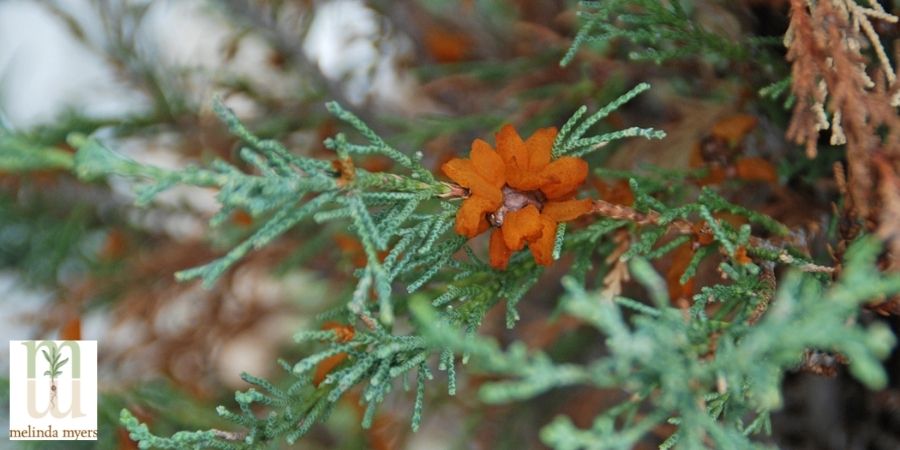What's Wrong with My Tree?
- horticulturist and gardening expertAugust 9, 2025
Trees are the bones of the landscape, and when their leaves develop spots, branches die, or their overall health declines, we may panic. Often, the disease is more of a cosmetic problem, and a healthy tree can tolerate the attack. Other times, you may need to intercede or call in a professional for diagnosis and treatment.
Start by identifying the plant that is affected. Knowing your plant’s identity can narrow down the possible causes of the problem. Use a plant ID app or consult with garden center staff, master gardeners or other knowledgeable plant person to identify your plant.
Next, take a closer look to see how much and what parts of the plant are showing symptoms. This can help with diagnosing the problem, determining the severity, and deciding if and what treatment may be needed.
With this information, you can do a bit of research on your own or enlist the help of your local University Extension Service or tree care professionals in your area. The more information you can provide the better the diagnosis. Consulting local experts helps narrow down the diseases to those commonly found in your area.
Here are a few of the more common diseases that attack deciduous trees, those that lose their leaves in winter. Reduce the risk of most of these by selecting disease-resistant varieties, planting your tree in the proper location, and giving it proper care.

Hawthorne with Rust Disease
Anthracnose - Fungal Disease
Keep an eye on your Sycamore, dogwood, maple, hickory, walnut, birch, oak, and ash when you experience a cool wet spring. Watch for irregular-shaped brown spots on the leaves of these susceptible trees.
You’ll find more spots on the younger growth and the lower leaves. The leaf spots usually occur along the veins and severely infected leaves may even curl and fall off.
Fortunately, healthy mature trees infected with this disease do not need to be treated unless they have lost most or all of their leaves several years in a row. Sycamores are the exception since twig and branch dieback can occur. Keep your tree healthy so it is able to tolerate the damage. Avoid the problem by growing less susceptible London plane tree (Platanus x acerifolia) or its anthracnose-resistant varieties like ‘Bloodgood’, ‘Columbia’, or ‘Liberty’. Consult a certified arborist if you are concerned about the health of your tree and are considering treatment.
Reduce the risk of this disease next season by raking and destroying fallen leaves. Bury or burn, if your municipality allows, infected leaves. Only compost infected leaves if your compost pile is hot enough, at least 140 to 150 degrees F, to kill most plant disease organisms.
Powdery Mildew - Common Fungal Disease
White powdery spots or patches on the leaves of bee balm, phlox, lilac, ninebark, maple, crape myrtle, roses, and a variety of other plants are a sure sign powdery mildew is present. In severe cases, the white substance covers the leaves and prevents sunlight from reaching the leaves, causing them to turn yellow and drop prematurely.

Powdery Mildew Disease on Norway Maple Tree
You will notice more problems during warm, dry summers on plants growing in shade and on young leaves and green shoots. Although this disease can negatively affect the plant’s beauty, it is not life-threatening. Control is not needed for the well-being of an otherwise healthy plant.
Reduce the risk of powdery mildew by growing mildew-resistant varieties. Ensure trees have sufficient space to reach their full size and receive the necessary amount of sunlight. Good air circulation and adequate sunlight help reduce the risk of this disease. Rake and destroy diseased leaves to reduce the source of infection next year.
Avoid excessive nitrogen fertilizer, which promotes lush succulent growth that is more susceptible to this and many other tree diseases. Using a low-nitrogen, slow-release fertilizer like Milorganite provides small amounts of nutrients over a longer period of time and does not promote lush, succulent growth.
Apple Scab - Common Fungal Disease
Leafless apples and crabapples are a common sight in summers following a cool, wet spring. Scab is a common apple and crabapple tree disease that causes olive-green to black spots on leaves and fruits. These spots can grow together and severely infected leaves will drop prematurely.
Rake and destroy the fallen leaves and fruit to reduce the source of disease for next year. Sanitation and drier weather can keep this disease to a tolerable level.

Crab Apple Tree With Scab Disease
As you may have discovered, these trees survive and return each year. If this is a yearly problem, detracting from the beauty of the landscape, consider replacing susceptible trees with resistant varieties. Resistant varieties are not immune and may develop some spotting when the weather conditions are favorable for this disease. Fortunately, the infection is usually minor and few, if any, leaves drop off the tree.
Replacing an established tree with a new, much smaller tree can leave your landscape looking a bit bare. Reduce the impact, if space allows, by planting your new disease-resistant tree in a nearby location. Once it becomes established and starts to steal the show, you can remove the older disease-susceptible apple tree. Or fill the empty space around your new tree with perennials, grasses, and annuals. As your new tree grows and begins to fill the space, move these temporary plantings accordingly.
Maple Tar Spot - Fungal Disease
The common name makes this disease makes it easy to identify. The black spots look like someone splattered tar on the leaves of your maple. It is one of the more noticeable diseases, but like many others, it is not detrimental to the vitality of healthy plants.
Norway, striped, and sycamore maples in parts of the U.S. and Canada are susceptible to a European tar spot fungus that found its way to North America. You may see our native silver and red maples infected with the North American native tar spot fungus.
You’ll see this disease more often in dense plantings and summers following a wet spring. Although the symptoms appear early in the season, they become more pronounced and noticeable over time.
The disease-causing fungi survive the winter on the tar spot infected leaves lying on the ground. Rake and destroy the leaves to help reduce the source of infection. Increase success by getting your neighbors to do the same.
Verticillium Wilt - Fatal Tree Disease
Sudden wilting and death of individual branches of maples, redbuds, and other susceptible trees may mean verticillium wilt has infected the plant.
The dead branches may occur on one side of the tree or be scattered throughout the canopy. Have a professional diagnose the problem since the symptoms can be confused with other non-disease disorders.
Though verticillium wilt is fatal, you can prolong the plant’s life with proper care. Remove grass growing under the tree and replace it with a three-inch layer of woodchips or other organic mulch. You’ll remove the competition for water and nutrients while keeping the roots cool and moist. Pull the mulch away from the trunk of the tree to prevent other issues caused by keeping the trunk covered and moist. Water trees thoroughly as needed during dry periods. Apply 10 gallons of water for every inch diameter of the trunk to the area under the branches.
Prune out dead branches as they occur. Disinfect tools between cuts by soaking them in alcohol for at least 30 seconds or treating them with a spray disinfectant that contains at least 70% alcohol to reduce the risk of spreading the disease.
Do not replace dead trees with wilt-susceptible plants. This disease is in the soil and will infect new plantings of verticillium wilt susceptible trees, shrubs, vegetables, and flowers.
Oak Wilt - Fatal Tree Disease
Proper identification is important when diagnosing this disease. The more susceptible red oak group includes red, scarlet, black, and pin oaks. These have pointed lobes, and their acorns take two seasons to mature. White oaks include white, bur, swamp white, and live oa,k and are moderately tolerant of the disease. They have rounded lobes and their acorns mature at the end of the first season.
Another difference exists inside the tree. The water-carrying vessels eventually become plugged into the white oak. This allows white oak logs to float when placed in water. Those of the red oak remain open so this wood sinks. More importantly, this internal difference makes the red oak more susceptible to decay and oak wilt disease.
This deadly tree disease can kill red oaks in as little as a month. You’ll first notice wilting then the death of single branches on the tree. The tips and edges of the leaves begin turning a bronze, tan, or dull green and may droop, curl or drop from the tree.
Spores of this disease spread from sick to healthy oak trees on picnic beetles. The beetles are attracted to trees recently wounded or damaged by wind, storms, and pruning. The disease also spreads through naturally occurring root grafts between oak trees.
Work with a certified arborist to remove infected trees. They must first sever any grafts between the infected trees to be removed and the healthy ones that will remain. Burn or bury the infected wood to prevent spreading the disease to healthy trees. If you keep it for firewood, remove the bark and cover the pile with a heavy tarp. Do not move logs and firewood harvested from oak wilt-infected trees or recently cut oak logs to areas infected with oak wilt disease.
Prune oak trees during the dormant season when picnic beetles as less active. If you must prune during the growing season, immediately cover the wounds with pruning paint.
Cedar-Apple Rust - Common Fungal Disease
“My tree has been slimed” is a common call I receive after a warm spring rain. No need to panic if you find a gelatinous orange substance on your evergreen. It is just the fruiting stage of cedar-apple rust.
This rust fungal disease spends half of its life on junipers, primarily Juniperus virginiana, often called red cedar, and the remainder on apples, crabapples, hawthorns, or quince. It does not kill either host but can cause some tip dieback and round ball-like growths called galls on the twigs and needles of junipers. These galls swell after a warm spring rain and produce orange gelatinous horns. These horns release fungal spores, infecting nearby apples, crabapples, hawthorns, and quince.
If infected, these plants develop orange spots on their leaves and fruit, and in severe infestations may drop some of their leaves. Fortunately, this is more of a cosmetic problem and otherwise healthy plants survive.

Cedar Apple Rust Tree Disease
Removing the alternate hosts within several hundred miles of your susceptible plant can prevent the problem. Unfortunately, the alternate host may be on your neighbor’s property, a nearby park, or a public right-of-way.
Avoid creating more problems in the future by buying rust-resistant trees and juniper varieties.
Fireblight - Bacterial Disease of Apple and Pear Trees
Another common apple disease is fireblight. This bacterial disease attacks other members of the rose family, including crabapples, pears, hawthorns, mountain ash, roses, quince, cotoneasters, and spirea.
Young trees can be killed quickly in just a few weeks. All parts of the plan,t including flowers, fruit, stems, trunks, and roots, can be infected. Early detection and sanitation can help manage this disease. Look for wilted or curled stem tips and sunken, discolored areas, known as cankers, on the stem.
Blossom blight appears shortly after bloom. Infested flowers look water-soaked and quickly turn black or brown. Shoot blight usually appears right after petals drop from the flowers. The stem wilts, tips curve over like a shepherd’s crook, and the stems turn brown or black as if it was burned.
Remove and destroy infected stems by pruning at least 12 inches below the canker. Disinfect tools between cuts by soaking them in alcohol for at least 30 seconds or treating them with a spray disinfectant that contains at least 70% alcohol to reduce the risk of spreading the disease
Provide proper can and avoid high nitrogen fertilizers that encourage lush succulent growth that is more susceptible to this disease. Using a low-nitrogen, slow-release fertilizer like Milorganite provides needed nutrients over a longer period of time without promoting lush, succulent growth.
Thousand Canker Disease - Fungus Spread by Walnut Twig Beetles
This is another disease that is spread from infected to healthy trees with the help of an insect. Both the fungi and the twig beetle are native to the western United States in areas with Arizona (Juglans major) and possibly southern California walnuts (Juglans californica) that appear to be resistant. Black walnuts (Juglans nigra), however, are very susceptible to this insect and disease. Millions of black walnut trees planted in western states have been killed by this disease. These organisms have spread beyond their western limits to some more eastern states, most likely on walnut firewood and logs.
It is difficult to detect thousand cankers in the early stages of infection. The walnut twig beetle that carries the disease on its body tunnels into the tree. The fungus kills the area under the tree bark, creating dead areas called cankers. When the walnut twig beetle populations are high, they form lots of cankers that eventually strangle that part of the tree. This restriction prevents water and nutrients from reaching the upper branches, causing them to turn yellow, wilt, and die.
There is no cure, but early detection and removal of infected trees are the current means of managing this disease. If you find walnut twig beetles in your black walnut tree, it is most likely infected with thousand canker disease.
Many states have imposed quarantines on wood products to prevent the disease from spreading into or throughout their state. Find out what your state is doing and how you can help prevent the spread.
We plant trees for their shade, beauty, and to be a long-lived asset to our landscapes. They require a significant investment of time and money. Proper tree care and working with tree care professionals can help keep your trees healthy and looking their best for decades to come.

